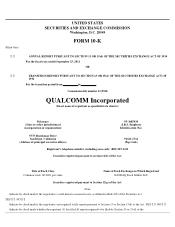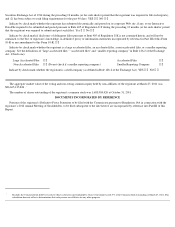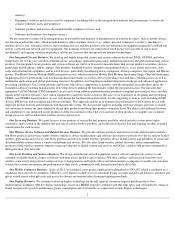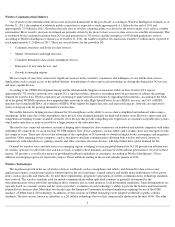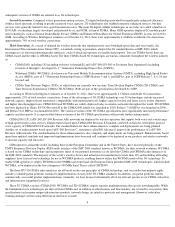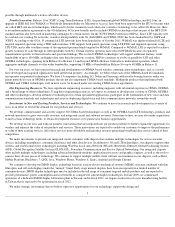Qualcomm 2011 Annual Report Download - page 8
Download and view the complete annual report
Please find page 8 of the 2011 Qualcomm annual report below. You can navigate through the pages in the report by either clicking on the pages listed below, or by using the keyword search tool below to find specific information within the annual report.
Wireless Communications Industry
Use of wireless telecommunications devices has increased dramatically in the past decade. According to Wireless Intelligence estimates as of
October 31, 2011, the number of worldwide mobile connections is expected to reach approximately 6.1 billion by the end of 2011 and
approximately 7.6 billion by 2015. Growth in the early days of wireless communications was driven by the need to make voice calls in a mobile
environment. More recently, increases in demand are primarily driven by the desire to have access to data services in a mobile environment. This
is evidenced by the continued transition from 2G (second generation) to 3G services and the emergence of 4G (fourth generation) services.
According to Wireless Intelligence estimates as of October 31, 2011, the number of global 3G connections reached 1.5 billion and is expected to
reach approximately 3.2 billion in 2015. There are several drivers for the growth in 3G:
The last couple of years have witnessed a significant increase in the consumer’s awareness and willingness to use mobile data services.
Applications such as email, access to the mobile Internet, downloading of videos and social networking are driving the demand for 3G services
and more capable devices.
According to the CDMA Development Group and the Global mobile Suppliers Association (GSA) in their October 2011 reports,
approximately 752 wireless networks now support 3G, a sign that wireless operators are making network investments to address the growing
demand for wireless data. Wireless operators are continuing to make network investments by upgrading their networks. According to the GSA,
all of the global WCDMA operators have upgraded their networks to offer High Speed Packet Access (HSPA) services, and 36% of HSPA
operators have launched HSPA+, an evolution of HSPA. With support for higher data rates and increased capacity, networks are expected to
evolve to keep up with the growing demand for wireless data.
The mobile Internet is helping increase demand for 3G smartphones as the ability to access data is simplified and enhanced when using a
smartphone. In the early days of the smartphone, these devices were designed primarily for high-end business users. However, innovation and
competition are helping to make available a broader set of devices that provide compelling user experiences at consumer acceptable price points,
which make such devices more accessible by a larger portion of the subscriber base.
The need to stay connected anywhere, anytime is helping drive demand for data connectivity on notebook and netbook computers with either
embedded 3G connectivity or via an external 3G USB modem. New device categories, such as tablets and e-readers, have also emerged over the
last couple of years. These new devices take advantage of the capabilities of 3G networks to download digital books, newspapers and magazines
anywhere. Other emerging device categories, such as machine-to-machine communication (allowing both wireless and wired systems to
communicate with other devices), gaming consoles and other consumer electronic devices, will help further drive global demand for 3G.
Demand for wireless voice and data services in emerging regions is helping to increase global demand for 3G. 3G provides an efficient way
for wireless operators to offer both voice and data services to address these demands, and since fixed broadband penetration is very low in these
regions, 3G presents a cost effective means of providing broadband capabilities to consumers. According to Wireless Intelligence, 3G net
additions in emerging regions are expected to surpass 2G net additions starting in the second calendar quarter of 2012.
Wireless Technologies
The significant growth in the use of wireless devices worldwide, such as smartphones and tablets, and demand for data services and
applications requires constant innovation to further improve the user experience, expand capacity and enable dense deployments of low power
nodes, such as picocells and femtocells. To meet these requirements, progressive generations of wireless communications technology standards
have evolved. The wireless standards used for mobile communications within individual countries is generally determined by the
telecommunication service providers operating in those countries and, in some instances, local government regulations. Such determinations are
typically based on economic criteria and the service provider’s evaluation of each technology’s ability to provide the features and functionality
required for its business plan. More than two decades ago, the European Community developed regulations requiring the use of the GSM
standard, a TDMA-based, 2G technology. In addition, several versions of CDMA technology were adopted worldwide as public cellular
standards. The first version, known as cdmaOne, is a 2G cellular technology that was first commercially deployed in the mid-1990s. The other
3
• Consumer awareness and desire for data services;
• Mature 3G networks with high data rates;
• Consumer demand for data-centric smartphone devices;
• Emergence of new data devices; and
• Growth in emerging regions.


